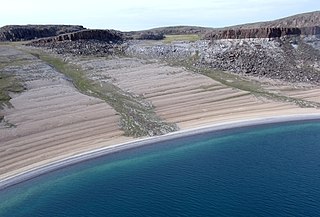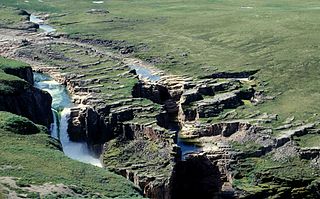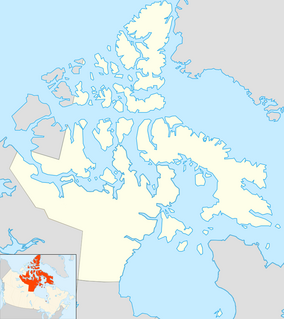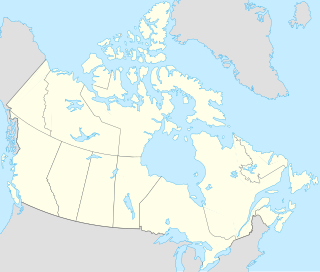
The geography of Canada describes the geographic features of Canada, the world's second largest country in total area.

The Arctic Archipelago, also known as the Canadian Arctic Archipelago, is a group of islands north of the Canadian mainland.

Bathurst Inlet is a deep inlet located along the northern coast of the Canadian mainland, at the east end of Coronation Gulf, into which the Burnside and Western rivers empty. The name, or its native equivalent Kingoak, is also used to identify the community of Bathurst Inlet located on the shore.

The Hood River of Nunavut, Canada, is a 400-kilometre (250 mi) long river draining into the Arctic Ocean from its headwaters in the interior of Canada's tundra at Takijuq Lake, close to the Northwest Territories border. The river ends at Arctic Sound near the community of Bathurst Inlet. The river is above the Arctic Circle and tree line.

Adelaide Peninsula (Iluilik), ancestral home to the Illuilirmiut Inuit, is a large peninsula in Nunavut, Canada. It is located at 68°06′N 097°48′W south of King William Island. Its namesake is Queen Adelaide, consort of King William IV of the United Kingdom.

Henik Lake is located in the Kivalliq Region of Nunavut, Canada. The lake is made up of two lakes, North Henik Lake and South Henik Lake with a narrows separating them. Of the two, North Henik Lake is the smaller with an area of 245 km2 (95 sq mi), while South Henik Lake has an area of 513 km2 (198 sq mi).
Cardigan Strait is a narrow waterway in the territory of Nunavut. It lies between the eastern coast of Devon Island and the western coast of Ellesmere Island. Norwegian Bay opens to the north. North Kent Island is situated within the strait.
The Peary Channel is a waterway in the territory of Nunavut. It is an arm of the Arctic Ocean, and it spreads southeast between Meighen Island to the north, Axel Heiberg Island to the east, Amund Ringnes Island to the southeast, Ellef Ringnes Island to the south. The channel is approximately 193 km (120 mi) long and 97 km (60 mi) wide.

Mary River is located on Baffin Island about 936 km (582 mi) northwest of Iqaluit, the capital of Nunavut, and about 176 km (109 mi) southwest of Pond Inlet. It is home to iron ore deposits discovered in 1962 by Murray Edmund Watts and Ron Sheardown and is being developed by the Baffinland Iron Mines Corporation.
There is a small airstrip, Mary River Aerodrome, located near the river.
The Jennings River is a river in far northern British Columbia, Canada, rising in the northern reaches of the Stikine Ranges of the Cassiar Mountains, at first running southwest, then turning northeast near the Tuya Range to enter Teslin Lake at its southern end, just to the east of the estuary of the Teslin River; also joining the lake in the same area is the Hayes River. The lower reaches of the Jennings form the boundary of the Nisutlin Plateau, which extends north into the Yukon along the eastern flank of Teslin Lake and to the west of the northernmost reaches of the Stikine Ranges; Simpson Peak is one of the few named summits in that region of the Stikines, and stands above the lower Jennings to the east of its estuary. To the south of the Jennings, west of the Tuya Range, is the Kawdy Plateau, which includes the small but rugged Atsutla Range, and southwest of which is the course of the Teslin River, which traverses the Kawdy, a subset of the Stikine Plateau, from south to north.
The Teslin Plateau is a plateau, of the Yukon Plateau physiographic section, in northern British Columbia, Canada, located north of the Nakina River between Atlin Lake and Teslin Lake.
Stratton Inlet is a body of water in the Qikiqtaaluk Region of Nunavut, Canada.
Powell Inlet is a body of water in the Qikiqtaaluk Region of Nunavut, Canada. It lies off the southern coast of Devon Island in the eastern high Arctic. Like Stratton Inlet, Burnett Inlet, Hobhouse Inlet, and Cuming Inlet, Powell Inlet is situated between Maxwell Bay and Croker Bay, north of Lancaster Sound and Barrow Strait.
Cuming Inlet is a body of water in the Qikiqtaaluk Region of Nunavut, Canada. It lies off the southern coast of Devon Island in the eastern high Arctic. Like Stratton Inlet, Burnett Inlet, Hobhouse Inlet, and Powell Inlet, Cuming Inlet is situated between Maxwell Bay and Croker Bay, north of Lancaster Sound and Barrow Strait.
The Taku River Tlingit First Nation are the band government of the Inland Tlinkit in far northern British Columbia, Canada and also in Yukon. They comprise two ḵwaan (tribes) of the Tlingit people, who are otherwise coastal, the Áa Tlein Ḵwáan of the Atlin Lake area and the Deisleen Ḵwáan of Teslin Lake, whose main focus is the Teslin Tlingit Council in Teslin, Yukon. Their band offices are in Atlin, British Columbia.
Padlei is a former community in the Kivalliq Region of Nunavut, Canada. It is located on the mainland on the north shore of Kinga (Kingarvalik) Lake at the juncture of the Maguse River. Whale Cove is to the east, while the Henik Lakes are to the southwest.
The Kunwak River is a river of Nunavut, Canada. It flows northeast out of Tulemalu Lake and enters Tebesjuak Lake, Mallery Lake and Princess Mary Lake before turning southeast and flowing into Thirty Mile Lake on the Kazan River.

The Horton River is a river in Inuvik and Sahtu Regions, Northwest Territories and Kitikmeot Region, Nunavut, Canada. It is a tributary of the Beaufort Sea and hence part of the Arctic Ocean drainage basin. Only the first few kilometres from its source are within Nunavut.

Bloody River is a river in Nunavut and the Northwest Territories, Canada. It flows into the Dease Arm of Great Bear Lake in the Northwest Territories at approximately 66°56′01″N 120°34′07″W.









